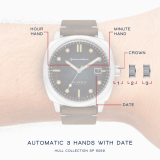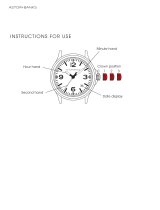
English
23
English
22
ACCURACY OF MECHANICAL WATCHES
●
The accuracy of mechanical watches is indicated by the daily rates of one week
or so.
●
The accuracy of mechanical watches may not fall within the specified range
of time accuracy because of loss/gain changes due to the conditions of use,
such as the length of time during which the watch is worn on the wrist, arm
movement, and whether the mainspring is wound up fully or not, etc.
●
The key components in mechanical watches are made of metals, which expand
or contract depending on temperatures due to metal properties. This exerts
an effect on the accuracy of the watches. Mechanical watches tend to lose
time at high temperatures while they tend to gain time at low temperatures.
●
In order to improve accuracy, it is important to regularly supply energy to
the balance that controls the speed of the gears. The driving force of the
mainspring that powers mechanical watches varies between when fully wound
and immediately before it is unwound. As the mainspring unwinds, the force
weakens.
Relatively steady accuracy can be obtained by wearing the watch on the wrist
frequently for the self-winding type and winding up the mainspring fully
everyday at a fixed time to move it regularly for the wind-up mechanical type.
●
When affected by a strong magnetism from outside, the mechanical watch
may loss /gain time temporarily. The parts of the watch may become
magnetized depending on the extent of the effect. In such a case, consult the
retailer from whom the watch was purchased since the watch requires repair
including demagnetizing.
SPECIFICATIONS
1 Features
Cal. 6R20, 6R21, 6R24 ................................. 6 hands, time display (Hour, minute and second
hands), day and date display, power reserve
indicator
Cal. 6R27 ...................................................... 5 hands, time display (Hour, minute and second
hands), date display, power reserve indicator
2 Vibrations per hour .............................................. 28,800
3 Loss/gain (daily rate) ........................................... +25 – 15 seconds at normal temperature range
(between 5°C and 35°C)
4 Continuous operating time ................................ More than approx. 45 hours
5 Driving system .................................................... Automatic winding type with manual winding
mechanism
6 Jewels
Cal. 6R20, 6R21, 6R27 ................................. 29 jewels
Cal. 6R24 ...................................................... 31 jewels
* The accuracy above is factory adjusted.
** Due to the characteristics of mechanical watches, any actual daily rate may not fall within the range
of time accuracy specified above dependent on the conditions of use, such as the length of time dur-
ing which the watch is worn on the wrist, temperature, arm movement, and whether the mainspring
is wound up fully or not, etc.















